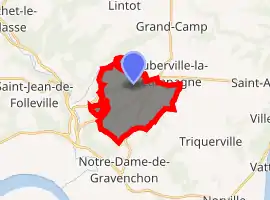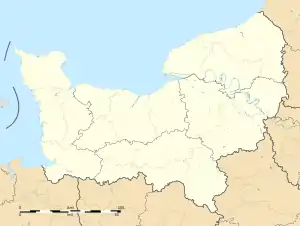La Frénaye
La Frénaye is a commune in the Seine-Maritime department in the Normandy region in northern France.
La Frénaye | |
|---|---|
.svg.png.webp) Coat of arms | |
Location of La Frénaye 
| |
 La Frénaye  La Frénaye | |
| Coordinates: 49°31′41″N 0°34′29″E | |
| Country | France |
| Region | Normandy |
| Department | Seine-Maritime |
| Arrondissement | Le Havre |
| Canton | Port-Jérôme-sur-Seine |
| Intercommunality | CA Caux vallée de Seine |
| Government | |
| • Mayor (2020–2026) | Christophe Tetrel |
| Area 1 | 10.02 km2 (3.87 sq mi) |
| Population (2017-01-01)[1] | 2,134 |
| • Density | 210/km2 (550/sq mi) |
| Time zone | UTC+01:00 (CET) |
| • Summer (DST) | UTC+02:00 (CEST) |
| INSEE/Postal code | 76281 /76170 |
| Elevation | 30–148 m (98–486 ft) (avg. 130 m or 430 ft) |
| 1 French Land Register data, which excludes lakes, ponds, glaciers > 1 km2 (0.386 sq mi or 247 acres) and river estuaries. | |
Geography
A village of forestry and farming in the Pays de Caux, some 20 miles (32 km) east of Le Havre, at the junction of the D484 and D982 roads.
History
The village is located on an old Roman road which runs from "Juliobona" (Lillebonne) to "Rotomagus" (Rouen). Another Roman road linking "Breviodurum" (Brionne) to "Mediolanum" (Évreux), also crosses La Frenaye's borders.
The name comes from the Latin fracsinus, meaning ‘’place of the ash trees’’.
The Gallo-Roman period is often mentioned in the history of the region, many relics having been found in excavations and having discovered the foundations of two military camps protecting the Roman roads.
A farm still operates to this day, bearing the name of ‘’Lionnière’’, supposedly used to keep the lions and other wild animals during the celebrations organised in the amphitheatre at Lillebonne.
The 1 August 1914 saw the mobilisation of 60 men of the village. 30 were killed and five were missing by the end of World War I.
In 1939, soldiers were again mobilised. In 1940 the exodus of Frenaysiens reached its peak, with rumours of German atrocities. During this period many Frenaysien soldiers were imprisoned in Germany or were requisitioned for compulsory labour. During the night of 7 August 1944, a Royal Air Force Lancaster crashed in La Frenaye. Three British airmen were killed and now rest in La Frenaye cemetery.[2] On 30 August 1944 the Germans left La Frenaye.
Population
| Year | 1962 | 1968 | 1975 | 1982 | 1990 | 1999 | 2006 |
|---|---|---|---|---|---|---|---|
| Population | 683 | 709 | 1082 | 1211 | 1535 | 1606 | 1755 |
| From the year 1962 on: No double counting—residents of multiple communes (e.g. students and military personnel) are counted only once. | |||||||
Places of interest
- The church of St. Jacques, dating from the sixteenth century.
- The chateau de Freneuse.
- An ancient manorhouse.
Twin towns
![]() South Wonston in Hampshire, England.
Rettenberg in Bavaria, Germany
South Wonston in Hampshire, England.
Rettenberg in Bavaria, Germany
References
- "Populations légales 2017". INSEE. Retrieved 6 January 2020.
- armées.com (7 August 1944). "Armées.com - Lancaster Crash in La Frenaye, Normandy". Xn--armes-dsa.com. Retrieved 26 March 2013.